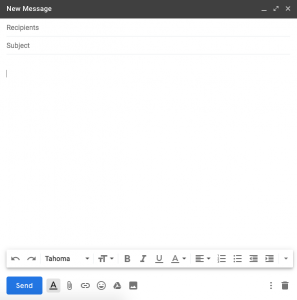
By Jes | Writing Center Program Specialist | April 24th, 2019
Writing emails may seem like a quick, easy process, but there is much more to it than just typing up words. We live in a world where face-to-face communication isn’t always possible, which means a lot of our communication occurs via email. Regardless of who you are emailing, it is important to write emails carefully to ensure they convey the right message and tone.
One thing you should always consider before writing an email is whether the topic you need to discuss is appropriate for email communication. Certain topics require either an immediate response or a more in-depth discussion that should be discussed over the phone or in-person to allow for clear, quick back-and-forth communication. Other subjects may be sensitive in nature and are best saved for face-to-face meetings, such as grades, performance in a class, or questions you may have after missing a class. It’s also best to work on class projects with fellow students in person rather than via email. If you’re not sure which method of communication is best for your topic, ask yourself how you would most like to be communicated with about it and decide from there.
Once you’ve decided to write an email, it’s crucial to realize one of the biggest drawbacks of communicating via email: it takes out all of the non-verbal cues we typically rely on in face-to-face communication to tell us how someone feels about what we say. Because there are no non-verbal cues, we can’t always determine how someone might react to the way things are worded in an email. Sometimes, even something as simple as communicating a deadline or saying “yep” instead of “yes” can rub someone the wrong way. According to David Swink, Chief Creative Officer of Strategic Interactions, Inc., it’s much more difficult when communicating via email to tell if the person you’re communicating with is in the same psychological climate as you. This means that while you may be in a good mood and feeling positive as you write, the email recipient may be under a lot of stress or in a bad mood when they read and apply a negative tone to the email. Additionally, if your message is ambiguous, most people will apply a negative tone to it regardless of the mood they are in (Swink). If there’s any room for a reader to view an email as negative, you may want to revise to ensure this doesn’t happen.
There are many things to keep in mind when reviewing or revising an email to make sure your intended tone will be clear. One of the most important things when writing an email is to always keep in mind your relationship with the person you are writing to (Swink). An email to a professor should have a much different tone than an email to a friend or fellow student. In addition, it’s best to avoid using text speak such as “lol” or “thx” and emojis unless you know the person you’re communicating with really well, as this may make some people feel as though you aren’t taking the email conversation seriously. Professional language should always be used when emailing with professors, employers, or co-workers. The use of all caps should be avoided as much as possible as well, as this can be interpreted as yelling or screaming and can make a message feel negative.
Another thing to consider when sending an email is that there is more to email than just sending and receiving information; email is also a way to keep up or build a relationship with someone (Swink). It’s a good idea to treat an email like you would a face-to-face communication by saying things like “I hope you’re having a great day” or “I look forward to hearing from you soon.” This may help your reader feel more connected to you as they would when speaking in person. You can also make emails feel more personal by inquiring about something specific to your reader, like a recent vacation, or by mentioning a conversation you recently had with them, if appropriate. Conversational devices such as these can make your email feel warmer and more personal, which can in turn make the email feel more positive.
If you’ve read over an email using the above suggestions and you’re still not sure if it has a good or positive tone, you can ask a friend, co-worker, or family member to read it over for you. If nobody is available to read the email for you, saving the email as a draft and re-reading it a few hours later before sending works, too. No matter how you choose to review and revise your emails, it’s always a good idea to do everything you can to prevent your emails from leaving a bad taste in your readers’ mouths.
—
Swink, David F. “Don’t Type at Me Like That! Email and Emotions.” Psychology Today, 12 Nov. 2013, www.psychologytoday.com/us/blog/threat-management/201311/dont-type-me-email-and-emotions. Accessed 26 Feb. 2019.
